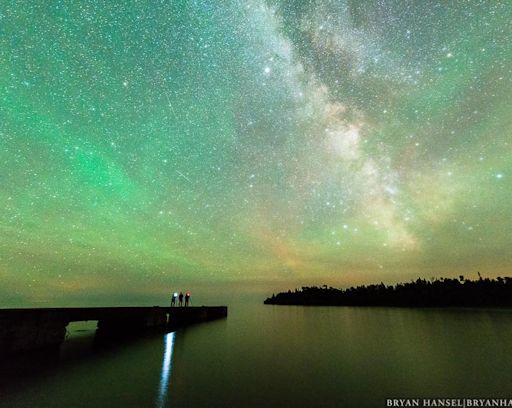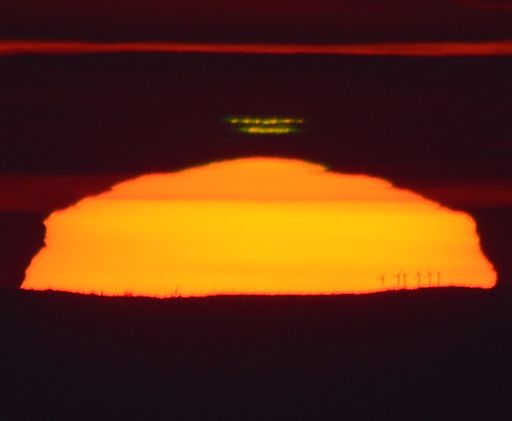Learn to photograph Northern Lights like a pro. Sign up for Peter Rosen's Aurora Photo Courses in Abisko National Park, winner of the TripAdvisor Certificate of Excellence Award 2015. | | | SUNSET SKY SHOW: When the sun sets tonight, step outside and look west. The crescent Moon and Venus are beaming through the twilight only ~2o apart. Try to catch them before the sky fades to black. A Moon-Venus conjunction framed by twilight blue is a lovely sight. [photo gallery] NORTHERN SKY TURNS GREEN, NO AURORAS REQUIRED: There was no geomagnetic storm last night. The sky turned green anyway. Photographer Bryan Hansel recorded the phenomenon on July 18th: 
The green glow was barely visible to the naked eye, but a deep-sky exposure with Hansel's Nikon D800 digital camera captured it easily. This is called "airglow." Although it resembles the aurora borealis, the underlying physics is different. Airglow is caused by an assortment of chemical reactions in the upper atmosphere driven mainly by solar ultraviolet radiation; auroras, on the other hand, are ignited by gusts of solar wind. Green airglow is best photographed from extremely dark sites on nights when the Moon is new or below the horizon. It often shows up in long exposures of the Milky Way. Indeed, the Milky Way was Hansel's actual target. "I run a Milky Way Photography Workshop," he explains."The figures on the dock are three of the photographers in my group and the light is from a camera's LCD screen." Realtime Space Weather Photo Gallery GREEN FRAGMENT BREAKS OFF THE SUN (NOT REALLY): On July 15th, Olivier Schuler was watching the sun set over Pic du Midi in the Pyrenees of France when a green fragment broke away from the solar disk. A 1/2000s exposure with his Nikon D7100 digital camera captured the event: 
Appearances notwithstanding, the sun is still intact. What happened? The green color gives it away. "It was a green flash," says Schuler, "bright enough to see with the naked eye." Green flashes are caused by temperature gradiants in the atmosphere, which magnify tiny differences in the atmospheric refraction of red and green light. Sometimes the magnification is very strong and voila!--a verdant mirage. The visibility of green flashes is improved by clear air. The view from Pic du Midi, home of one of the world's greatest astronomical observatories, was very clear. "In the picture," points out Schuler, "you can see a wind farm located 200 km from my observing site." Solar flare alerts: text or voice. Realtime Green Flash Photo Gallery
Realtime Aurora Photo Gallery
Realtime Sprite Photo Gallery
Realtime NLC Photo Gallery. Every night, a network of NASA all-sky cameras scans the skies above the United States for meteoritic fireballs. Automated software maintained by NASA's Meteoroid Environment Office calculates their orbits, velocity, penetration depth in Earth's atmosphere and many other characteristics. Daily results are presented here on Spaceweather.com. On Jul. 18, 2015, the network reported 15 fireballs.
(11 sporadics, 1 Southern delta Aquariid, 1 July Pegasid, 1 Northern June Aquilid, 1 alpha Capricornid)  In this diagram of the inner solar system, all of the fireball orbits intersect at a single point--Earth. The orbits are color-coded by velocity, from slow (red) to fast (blue). [Larger image] [movies] Potentially Hazardous Asteroids ( PHAs) are space rocks larger than approximately 100m that can come closer to Earth than 0.05 AU. None of the known PHAs is on a collision course with our planet, although astronomers are finding new ones all the time. On July 18, 2015 there were potentially hazardous asteroids. Notes: LD means "Lunar Distance." 1 LD = 384,401 km, the distance between Earth and the Moon. 1 LD also equals 0.00256 AU. MAG is the visual magnitude of the asteroid on the date of closest approach. | | The official U.S. government space weather bureau | | | The first place to look for information about sundogs, pillars, rainbows and related phenomena. | | | Researchers call it a "Hubble for the sun." SDO is the most advanced solar observatory ever. | | | 3D views of the sun from NASA's Solar and Terrestrial Relations Observatory | | | Realtime and archival images of the Sun from SOHO. | | | from the NOAA Space Environment Center | | | the underlying science of space weather | | | Web-based high school science course with free enrollment | | 
